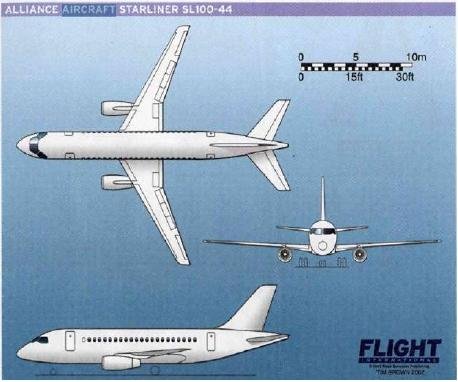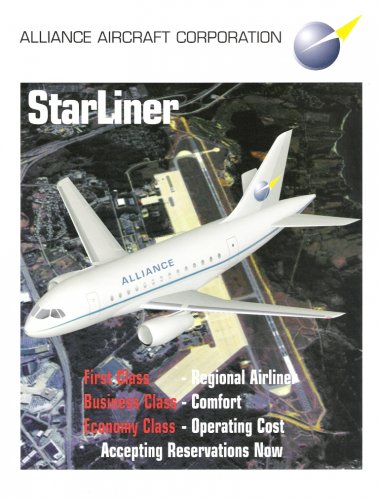The image below is taken from the cover of an Alliance Aircraft Corporation brochure from a Farnborough Show (around 2000?) for the StarLiner SL-200 and SL-300 passenger transports. These appear to a scaled up SL100-44.
At the time the brochure was printed, the CEO was Earl Robinson and the constructor details were Alliance Aircraft Corporation, Pease International Tradeport, Portsmouth, New Hampshire USA.
The family of Alliance passenger transport aircraft were known as StarLiner's. The SL-200 (70 seat) and SL-300 (90 seat) were to be developed for entry into service in 2003, with a potential development for a 110 seat version.
The engine was to be consistent across the range of types with the Rolls-Royce BR-700 family being considered as the baseline for the StarLiner fleet. It was envisaged that there would be less than one maintainence manhour per flight hour.
According to the brochure, the details were as follows:
Alliance StarLiner SL-200
Length: 27.5 m
Wingspan: 28.2 m
Wing Area: 80 sq m
Cabin Width: 3.45 m
Range: 4,540 km with 70 passengers
Passenger Capacity: 70 seats
Operational Empty Weight: 44,700 lb / 20,270 kg
Max Take-off Empty Weight: 78,500 lb / 35,600 kg
Max Landing Empty Weight: 75,000 lb / 34,100 kg
Payload Weight: 18,000 lb / 8,165 kg
Service Ceiling: 41,000 ft / 12,497 m
Maximum Speed: 0.84 Mach
Maximum Cruise at 26,000 ft (7,925 m): 350 kts / 403 mph / 648 km/h
Fuel Capacity: 24000 lbs / 10,880 kg
Take-off Distance: 4,500 ft / 1,372 m
Landing Distance: 3,500 ft / 1,067 m
Rolls Royce BR-700: 2 x 13,500 lb
Alliance StarLiner SL-300
Length: 31.6 m
Wingspan: 28.2 m
Wing Area: 80 sq m
Cabin Width: 3.45 m
Range: 3,970 km with 90 passengers
Passenger Capacity 90 seats
Operational Empty Weight: 51,300 lb / 23,265 kg
Max Take-off Empty Weight: 92,500 lb / 41,950 kg
Max Landing Empty Weight: 89,000 lb / 40,360 kg
Payload Weight: 22,000 lb / 9,880 kg
Service Ceiling: 41,000 ft / 12,497 m
Maximum Speed: 0.84 Mach
Maximum Cruise at 26,000 ft (7,925 m): 350 kts / 403 mph / 648 km/h
Fuel Capacity: 24000 lbs / 10,880 kg
Take-off Distance: 5,000 ft / 1,524 m
Landing Distance: 4,000 ft / 1,219 m
Rolls Royce BR-700: 2 x 16,000 lb
Features cited included:
- Clean Operation
- Honeywell Auxilliary Power Unit
- Thrust Reversers
- Glass Cockpit
- Honeywell EPIC Avionics System
- Full Authority Fly-By-Wire fligt control System
- Integrated /autoland
- Meets Latest Airline Requirements & Certification Standards
- Excellent External Low-Noise Standards
- Excellent Emissions Rating
- Common Crew Rating Across StarLiner Family
- High 0.80+ Mach Speed
- Low Maintainance Costs
- Flexible Cabin Layout
- Wide 20 Inch Aisle
- Wide 20 Inch Seats
- 32 Inch seat Pitch
- Forward and Aft Passenger and Service Door
- Large Under Floor Baggage Area
- Low-level Of Cabin Noise
- Passenger Entertainment System
- One hour Engine Change
There was some talk in Flight International's World Airliners Directory (2-18 November 2002) of proposed collabarations with the Chinese AVIC organisation. By 2002 the Alliance Aircraft were based in Martinsburg, West Virginia.
Does anyone know if any of the methods or technologies from this project emerged as part of any later Chinese passenger transport projects like the C919?



